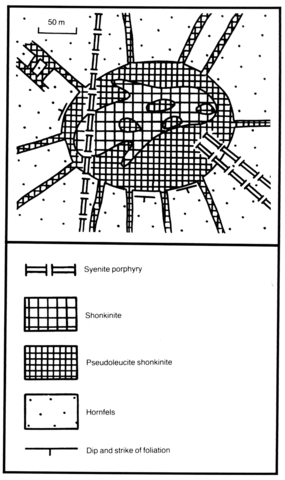stripes
Rododendron is a circular stock, 200-300 m in diameter, which cuts sandstones of Jurassic age. The name derives from the abundance of rhododendrons growing in the area. In the central part it is formed by shonkinite and syenite around which are shonkinite porphyries and syenite porphyries. In the marginal parts of the intrusion volcanic formations, predominantly tuffaceous sandstones and tuff breccias, have been preserved. Compositionally the volcanic rocks are mainly trachytes, which are hornfelsed in the marginal parts of the stock, but leucite- bearing trachytes are also present. The trachytes are porphyritic rocks with phenocrysts of biotite, orthoclase, rarer sodic plagioclase (An20-30) and sometimes apatite in a fine-grained trachytic base (50-60%). In the leucite-bearing trachytes phenocrysts are represented by salite, which is sometimes replaced by arfvedsonite. In the trachytic matrix, in which phenocrysts of leucite are replaced by sericite, phlogopite occurs and melanite, fluorite and titanite are patchily developed. The shonkinite porphyries are dark rocks with augite phenocrysts (30-40%) and a small amount of biotite (up to 10%) with large pseudoleucites, olivine and altered hornblende (6%). The groundmass is formed of K-feldspar, biotite, augite, plagioclase (An40-50) and tiny grains of leucite, apatite and magnetite. The syenite porphyries are leucocratic coarse-grained rocks with phenocrysts of orthoclase, plagioclase, augite, hornblende, biotite and sometimes isolated olivine grains. The groundmass is orthoclase and plagioclase (An20-30) with some augite, biotite and olivine. The central shonkinites are of two types: one with nepheline, the other with pseudoleucite. Apart from the pseudoleucite and nepheline, orthoclase, augite, phlogopite, isolated olivine grains, apatite, titanite, magnetite and pyrite also occur. The central syenites are formed mainly of orthoclase perthite and aegirine with accessory apatite, zircon, fluorite and magnetite and secondary biotite, albite, titanite and pyrite.
EREMEYEV, N.V. 1987. Potassic alkaline magmatism Verhne-Yakokutsy graben (central Aldan). Izvestiya Akademii Nauk SSSR, Seriya Geologiya, 1: 126-30.
ORLOVA, M.P. 1990. Mesozoic stage of magmatism. In G.V. Polyakov and V.V. Kepezinskas (eds) Potassic alkaline magmatism of the Baikal-Stanovoy rift system. 65-123. Nauka, Siberian Division of the USSR Academy of Sciences, Novosibirsk.

